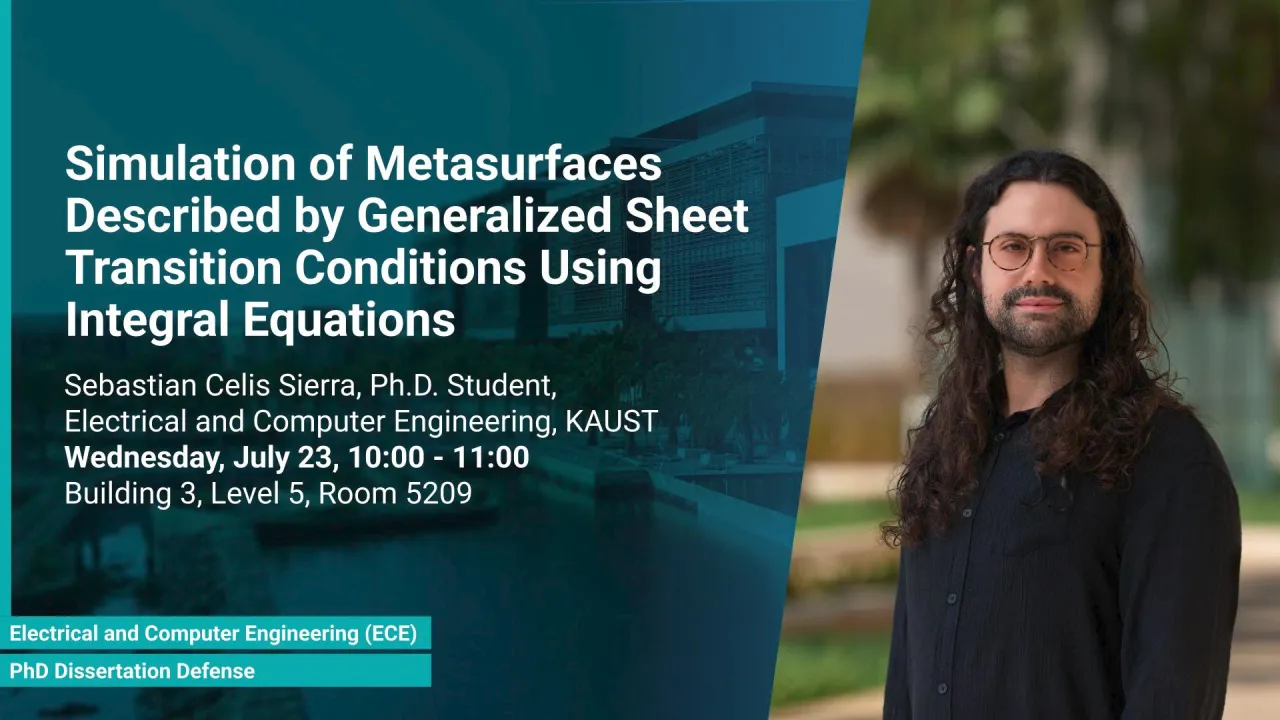
Simulation of Metasurfaces Described by Generalized Sheet Transition Conditions Using Integral Equations
This dissertation details the development of several novel integral equation solvers that incorporate Generalized Sheet Transition Conditions (GSTCs) to enable the accurate and computationally efficient simulation of complex, multiscale metasurfaces in three-dimensional problems.
Overview
Metasurfaces, the two-dimensional (2D) alternative to traditional bulky three-dimensional (3D) metamaterials, offer a compact, cost-effective, and low-loss solution for precise control of electromagnetic waves/fields. Their impact is already being seen in wireless communications, improving the efficiency of antennas, end-user devices, and the wireless propagation channels. The response of a metasurface is influenced primarily by its constituent materials and the arrangement of its sub-wavelength ``atom-like" unit cells. These unit cells function as resonators, capable of modifying the properties of electromagnetic fields based on their configuration. Consequently, metasurface design typically relies on simulations of a single unit cell with periodic boundary conditions. However, challenges arise when simulating metasurfaces deployed in their embedded environments, a nontrivial task that demands considerable computational resources.
The challenge of simulating metasurfaces arises from their overall dimensions, which are typically much larger than the operational wavelength; while the dimensions of the unit cells remain significantly smaller, often on the order of sub-wavelength. The multiscale nature of the problem, when discretized, results in large and often ill-conditioned matrices, requiring significant computational resources. To address this challenge, the metasurface can be replaced by an infinitesimally thin sheet where the generalized sheet transition conditions (GSTCs) are enforced to ``connect" the electromagnetic fields on its two sides. GSTCs employ equivalent electric and magnetic surface susceptibility tensors to impose the desired response of the metasurface. By eliminating the need for multiscale discretization, the use of GSTCs significantly enhances computational efficiency.
Although GSTCs have been integrated into various Maxwell equation solvers such as finite-difference frequency domain (FDFD), finite element (FEM), finite-difference time domain (FDTD), and discontinuous Galerkin time-domain (DGTD) methods, these solvers retain limitations inherent to their differential equation-based formulations. In contrast, integral equation solvers overcome these drawbacks by discretizing only the scatterers rather than the entire computation domain, significantly reducing the number of discretization elements and naturally incorporating radiation conditions.
This dissertation details the development of several integral equation solvers to simulate metasurfaces accurately in 3D problems. These solvers couple various surface integral equations (SIEs) and thin sheet volume integral equations (VIEs) with GSTCs either explicitly or implicitly. The advantages and drawbacks of each implementation are fully studied in the dissertation.
For monoanisotropic arbitrarly-shaped closed metasurfaces, a multi-trace method is developed for solving the coupled SIE-GSTC equations. A numerical scheme is used to compute the electric and magnetic susceptibility tensors in GSTCs from the desired metasurface response. This scheme reduces the normal components of the electric and magnetic polarization densities to simplify the implementation. While this approach has proven effective in a wide range of
scenarios, under certain conditions, the absence of normal components can impact the accuracy of the solver.
For bianisotropic open metasurfaces, an efficient and accurate scheme is developed on the basis of a novel single-trace SIE-GSTC formulation. The SIEs, formulated in open form, are coupled with the full GSTCs under a compact framework. A comprehensive methodology is introduced to handle both the tangential and normal components of the fields used in GSTCs. A gradient calculation scheme over triangular patches is implemented to accurately incorporate the normal components into the SIEs framework.
Finally, to further simplify the incorporation of the normal components of the fields used in the GSTCs, a thin-sheet VIE formulation is employed. This approach effectively manages both tangential and normal currents, ensuring an accurate representation of polarization currents in the bianisotropic representation of the metasurface, while converting the VIE into an SIE, thereby enhancing computational efficiency.
Numerical examples are provided to demonstrate the accuracy, efficiency, and broad applicability of the proposed solvers.
Presenters
Brief Biography
Sebastian Celis Sierra is a Ph.D. candidate in Electrical and Computer Engineering at King Abdullah University of Science and Technology (KAUST), where he develops advanced integral-equation solvers for the accurate simulation of electromagnetic metasurfaces. He holds an M.S. in Electrical Engineering (2018–2020) from KAUST and dual B.Eng. degrees in Electrical/Power Engineering and Electronics Engineering (2014–2018) from Universidad de los Andes, Bogotá.

